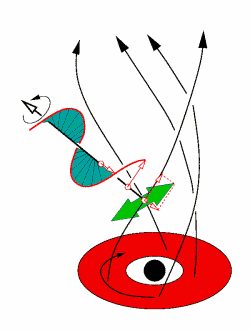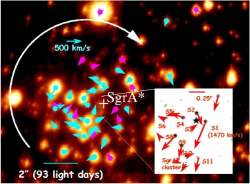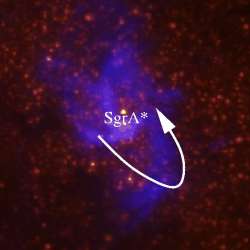 |
|
Figure 1:
The linearly polarised radio emission of energetic electrons
within the back side magnetic field lines (green arrow indicats the
plane of linear polarisation) converts partly into circular
polarisation during its journey throught the foreground magnetic
fields. This conversion is due to the fact that radio emission, with
linear polarisation parallel to the magnetic field lines, propagates
slower than radio emission, with perpendicular linear
polarisation. Our polarised radio emission has perpendicular and
parallel components, which oscillate in phase. Caused by the different
propagation speeds they get out of phase. The combination of the out
of phase osscilating components produces a circular oscillation of the
electric field, as sketched.
|
|
|  |
For 20 years now astronomer have been observing that the
radio emission of the 2.6 Million solar masses heavy SgrA* is rotating
counter-clockwise. This is suprising, since this rotational sense
is nearly the only constant quantity in the violent events around the black
hole. The accretion disk, a gaseous disk, rotates around the black
hole within roughly one hour and therewhile launches radio-emitting jets.
The luminosity of the jets, and also their linear and circular polarisation
vary strongly.
The new model is based on two assumptions that are motivated
by these observations. First, there is a constant mechanism which explains
the persistent rotational sense of the radio emission. Second, this mechanism
works under strongly varying conditions. In contrast to previous models,
this approach does not assume that the magnetic fields within the jets
have a permanent polarity (for over 20 years in the case of SgrA*, which
would be surprising because of the rapid variations of physical quantities
of that system within hours). The new mechanism works even if the magnetic
fields change their polarity. It is based on the assumption, that - due
to the rotation of the accretion disk - the magnetic fields are twisted.
The radiation of the jets is modified by the twisted magnetic
fields in a way that the oscillations of the electric fields are partly
changed: Some fraction of the linear polarisation is converted into circular
polarisation. Figure 1 shows that the circular polarisation rotates retrograde
with respect to the accretion disk.
This implies in the case of SgrA* that its accretion disk rotates
clockwise. With this model the 20 year constant rotational sense of
the circular polarisation can be explained. It only depends on the
rotational sense of the accretion disk, which should change very
rarely. The rotation of the accretion disk is likely due to winds of
a group of young, hot stars, which orbit around SgrA*. Observations
show that they also orbit clockwise around the black hole (see figure 2).
If additional support for the proposed mechanism could
be found, the still unobservable rotational sense of accretion disks
around black holes can be determined observationally by measurements of
their circular polarized radio emission.
Torsten Enßlin
Literature/Links:
|  |
 |
|
Figure 2:
Star cluster around SgrA* (image from
Gentzel 2000).
The arrows indicate the directions of individual stars. The
blue marked stars are young, hot stars. Their winds are beliefed to feed
SgrA* with gas. Since the stars rotate preferentially clockwise, the accretion
disk formed from their winds should rotate in the same sense - clockwise,
as also predicted by the model.
|
|
 |
|
Figure 3:
Molecular cloud in the centre of the Galaxy (blue: radio
by Yusef-Zadek & Morris. red: FIR by Phillip, Zykla, & Mezger).
SgrA* and the central star cluster is located in the cloud's centre. The
rotation of the cloud is - as that of the Milkey Way - retrograde with
respect to the direction of the young, hot stars and the rotational sense
of SgrA* as derived from the circular polarisation.
|
|
|